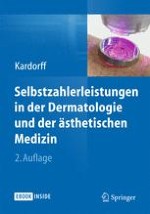Zusammenfassung
Resorbierbare dermale Filler, wie quervernetzte Hyaluronsäure
, werden in oder unter die Haut injiziert, um Linien und Falten zu korrigieren, Konturen zu schaffen, Volumen zu geben oder um Lippen und kleinere Gewebedefekte aufzufüllen. Die Produkte werden hauptsächlich im Gesichtsbereich eingesetzt, wo sie durch eine Spritze mit einer dünnen Nadel in die Dermis eingespritzt werden. Aktuelle Studien, therapeutische Strategien, praktische Anwendungshinweise zur Fillertherapie allgemein sowie detaillierte Informationen zu den Produktlinien Emervel und Restylane beinhaltet dieser ausführliche und gut bebilderte Beitrag, der wie ein Lehrbuch zur Fillertherapie aufgebaut ist.











